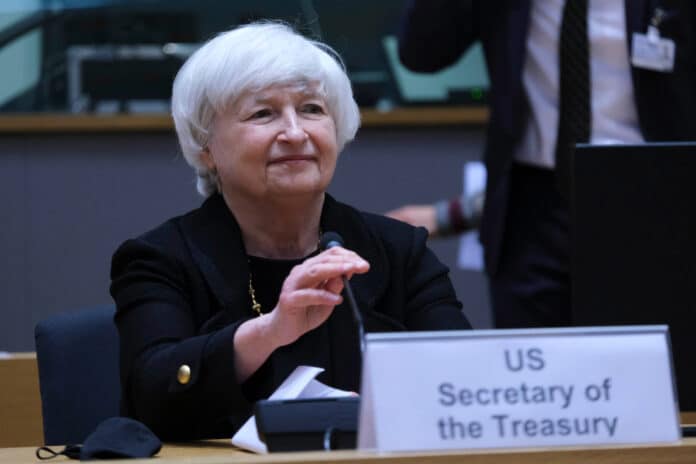
Treasury Secretary Janet Yellen said in a recent interview that she believes Americans are aware that, despite President Joe Biden’s rhetoric on falling inflation, prices, on the whole, are not going to fall.
Ms. Yellen made the remarks in a Jan. 25 interview on ABC News, in which she touted the administration’s Bidenomics policies and said she sees no reason why gloomy predictions for a recession this year would come true.
“I think 2024 is going to be a very good economic year. That said, there are always risks,” Ms. Yellen told ABC News’ Elizabeth Schulze in the interview.
The Treasury Secretary then addressed the matter of inflation, noting that the prices of essentials like rent and food “are maybe 20 percent higher than they were before the pandemic,” before adding that price increases have now “just about normalized.”
Ms. Yellen was then asked how to communicate to voters the fact that prices probably won’t actually fall to where they were before the pandemic, despite President Biden’s repeated remarks on falling inflation.
“Well, I think most Americans know that prices are not likely to fall,” Ms. Yellen replied. “It’s not the Fed’s objective to try to push the level of prices back to where they were.”
While the pace of inflation has fallen more or less steadily from the recent June 2022 peak of 9 percent down to 3.4 percent in December 2023, this doesn’t actually mean prices have fallen, just that they’ve been rising at a slower pace.
In his numerous remarks on inflation, President Biden hasn’t always made it a point to distinguish between falling prices (meaning negative rates of inflation) and falling inflation (positive rates of inflation, but smaller than the previous month).
For instance, on the occasion of the release of the November 2023 inflation report, the president mentioned the two concepts in the same breath.
“Today’s report demonstrates continued progress bringing inflation down and lowering costs for American families. Inflation is now at 3.1 percent — down by nearly two thirds from its peak,” he said on Dec. 12, when the November data on the consumer price index (CPI), a common measure of inflation, was released by the Bureau of Labor Statistics.
While the prices of some products and services did actually fall that month (e.g. used cars and trucks down 3.8 percent year-over-year in November), prices on the whole rose 3.1 percent in annualized terms.
The Federal Reserve’s inflation target is around 2 percent, with Ms. Yellen acknowledging in the ABC News interview that the Biden administration has more work to do to bring down the pace of price increases closer to the target — while making clear that consumers’ expectations for broad-based price drops are a pipe dream.
Some prices fell — but not overall
The latest CPI inflation report (for December 2023) showed that the prices of some goods and services did fall — although, on the whole, prices rose.
“Despite what many forecasters were predicting a year ago, inflation is down,” President Biden said in remarks on the CPI report.
“Today’s report shows that we ended 2023 with inflation down nearly two-thirds from its peak and core inflation at its lowest level since May 2021,” he continued.
Indeed, the December CPI report showed that inflation was 3.4 percent in annualized terms, compared to the June 2022 recent peak of 9 percent.
“We saw prices go down over the course of the year for goods and services that are important for American households like a gallon of gas, a gallon of milk, a dozen eggs, toys, appliances, car rentals, and airline fares,” the president accurately stated.
A detailed category-by-category inflation rate breakdown shows the percentage declines for the past 12 months through December in the prices of goods mentioned by the president: regular unleaded gasoline (-2.2 percent), milk (-1.8 percent), eggs (-23.8 percent), toys (-4.5 percent), appliances (-4.0 percent), car rental (-12.1 percent), and airline fares (-9.4 percent).
While President Biden’s remarks about prices in certain categories of goods falling is true, the prices of certain other goods rose significantly in the past year. And, importantly, prices on the whole increased by 3.4 percent — a faster pace of inflation than the Fed’s 2 percent target.
For example, the following categories all saw increases in the past 12 months through December: bread (3.1 percent), beef (8.7 percent), baby formula (7.3 percent), oranges (5.3 percent), and frozen vegetables (6.1 percent).
Alternative inflation measures
A number of Americans have expressed skepticism regarding the official rates of inflation, with some saying online in other forums that their lived experience suggests prices have gone up more than official government statistics suggest.
An alternative CPI inflation gauge developed by economist John Williams, calculated according to the same methodology used by the U.S. government in the 1980s, puts the actual inflation figure at roughly double the official figure. This means that rather than 3.4 percent year-over-year in December, the pace of inflation would actually be closer to 7 percent.
Mr. Williams views the current BLS methodology for calculating inflation as a flawed measure of how members of the general public experience changes in their cost of living.
“Individuals look to the government’s CPI as a measure of the cost of living of maintaining a constant standard of living, as well as measuring that cost of living in terms of out-of-pocket expenses. Without meeting those parameters, an inflation measure has limited, if any, use for an individual,” Williams wrote in a note elaborating on his theory.
“Where the CPI at one time met those parameters desired by the public, government efforts turned the CPI away from measuring the price changes in a fixed-weight basket of goods and services to a quasi-substitution-based basket of goods, which destroyed the concept of the CPI as a measure of the cost of living of maintaining a constant standard of living,” he said.
Mr. Williams’ alternative approach to CPI inflation has its critics, including economist Ed Dolan, senior fellow at the Niskanen Center.
In a blog post analyzing Mr. Williams’s approach, Mr. Dolan says he shares Mr. Williams’s view that the current government methodology understates inflation.
However, for various reasons, Mr. Dolan believes that rates of inflation provided by Mr. Williams’s method are too high and that a more accurate rate of inflation could be arrived at by subtracting roughly 2.45 percentage points from Mr. Williams’ numbers.
Either way, alternate inflation measures suggest that Americans have seen prices go up during President Biden’s term by more than the 17 percent that official estimates indicate.
Mr. Williams’ measure would put that figure at roughly 34 percent, while Mr. Dolan’s would put it at around 31.5 percent.
Former President Donald Trump said recently that he believes the cumulative level of inflation since he left office is over 30 percent — while predicting that if he doesn’t win the 2024 election, America will suffer a historic stock market crash and a Great Depression-style event.

















